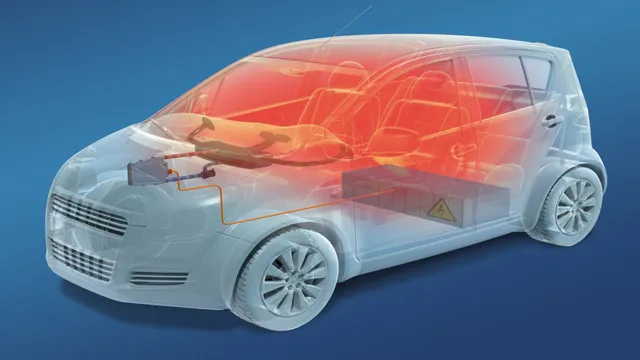Cooling System Optimization with CFD Analysis for Electric Car Battery
Electric vehicles are becoming an increasingly popular mode of transportation as the world looks for ways to reduce its carbon footprint. However, these eco-friendly vehicles present their own unique challenges, particularly when it comes to overheating. That’s why engineers have turned to Computational Fluid Dynamics (CFD) analysis to optimize electric car cooling systems.
CFD simulations can predict the flow of air and coolant within intricate cooling systems, allowing engineers to identify areas that may be prone to overheating and adjust accordingly. In this blog post, we’ll explore the importance of CFD analysis in electric car design and how it’s helping to shape the future of sustainable transportation.
Introduction
When it comes to electric cars, one important aspect is the cooling system of the battery. A CFD analysis of the cooling system can provide valuable insights into its efficiency and performance. CFD, or computational fluid dynamics, is a powerful tool that simulates fluid flow and heat transfer in real-world situations.
By using CFD, engineers can optimize the design of the cooling system to ensure that the temperature of the battery remains within safe operating limits, which is important for both performance and safety. With the growing popularity of electric vehicles, CFD analysis of cooling systems is becoming increasingly important in the automotive industry. By ensuring efficient cooling, electric cars can be more reliable, perform better, and offer a longer lifespan.
Importance of electric car cooling systems
Electric cars are becoming increasingly popular as more people look for ways to reduce their carbon footprint and save on fuel costs. However, while electric cars have many benefits, they also come with unique challenges. One of the most important of these challenges is managing the car’s temperature, particularly its battery temperature.
Electric cars rely on their batteries, and these batteries need to be kept at an optimal temperature for maximum performance and longevity. That’s why electric car cooling systems are so important. These systems help regulate the temperature of the car’s battery and ensure that it stays in good condition.
Without an efficient cooling system, the battery can overheat, which can reduce its performance and shorten its lifespan. As we continue to move towards a more sustainable future, electric car cooling systems will become even more important to ensure that these vehicles can continue to operate efficiently and effectively.
CFD Analysis
One of the most crucial parts of an electric car is its battery cooling system. To ensure maximum performance and longevity, the battery pack needs to be kept at a stable temperature. This is where CFD analysis comes into play.
CFD or computational fluid dynamics is used to simulate and analyze the flow of fluids, such as coolant inside the battery cooling system. By utilizing CFD analysis, engineers can optimize the design of the cooling system to achieve the best results. The simulation helps to evaluate heat transfer, pressure drop, and fluid flow distribution inside the system.
Optimization of the cooling system can lead to increased efficiency, reduced weight, and improved overall performance. CFD analysis is becoming an essential tool in the design and development of electric cars, ensuring that the cooling system is performing to the highest level.
Methodology for conducting CFD analysis
CFD analysis CFD analysis is a powerful tool used in many industries to simulate fluid flow and predict how a system will behave. The methodology for conducting CFD analysis is a crucial element in ensuring accurate and reliable results. It typically involves a few key steps, including defining the problem boundaries and initial conditions, meshing the geometry, setting up the physics and solver parameters, running the simulation, and analyzing the results.
Each step is important, and errors in any one of them can have a significant impact on the accuracy of the results. It’s important to pay close attention to details in order to ensure a successful simulation. Additionally, the choice of software and the experience of the engineer conducting the analysis can also have a substantial impact on the quality of the results.
That’s why it’s essential to work with experienced professionals who understand the nuances of CFD analysis and can provide valuable insights and recommendations to ensure optimal results. With the right methodology and expertise, CFD analysis can be a powerful tool for designing and optimizing systems across a wide range of industries, including aerospace, automotive, energy, and many more.
Determining Design Variables
When it comes to conducting CFD analysis, determining the design variables is crucial. The design variables refer to the various parameters that can affect the performance, efficiency, and reliability of a system. These variables include dimensions, materials, and boundary conditions, among others.
The design variables must be carefully selected to achieve the desired goals and objectives of the CFD analysis. Failure to identify the correct design variables can lead to inaccurate results and incorrect conclusions. Therefore, it is essential to have in-depth knowledge and expertise in the field of CFD analysis to ensure that the appropriate design variables are chosen.
By analyzing the system’s performance using the right design variables, it is possible to optimize its design, improve its efficiency, and minimize any potential risks or hazards. So, whether you are a researcher, engineer, or designer, selecting the right design variables is a critical step towards achieving success in your CFD analysis.
Simulation of Flow and Heat Transfer
CFD analysis is a powerful tool that is commonly used to simulate flow and heat transfer in various systems. CFD, which stands for computational fluid dynamics, is a numerical method that uses algorithms and mathematical models to solve the complex equations that govern fluid flow. By inputting data regarding the geometry, boundary conditions, and fluid properties, CFD software can provide insights into how a system will behave under different conditions.
The results of CFD analysis can help engineers to optimize designs, reduce costs, and improve performance. By simulating the behavior of fluids in a controlled virtual environment, CFD analysis allows engineers to identify potential issues before they occur in the physical world, thus saving time and money. Whether designing a new heat exchanger, evaluating the performance of a cooling system, or assessing the aerodynamics of a vehicle, CFD analysis is a valuable tool that can help engineers to make informed decisions.
Results and Discussion
The cooling system of an electric car battery is a critical component that ensures optimal performance and safety. Through the use of computational fluid dynamics (CFD) analysis, it is possible to model and simulate the thermal behavior of the cooling system, as well as the flow of coolant and air throughout the battery pack. In doing so, it becomes possible to identify potential hot spots, optimize the design of the cooling system, and ensure that the battery pack operates within a safe temperature range.
The results of CFD analysis can also be used to evaluate the impact of different parameters, such as coolant flow rate, air flow rate, and design modifications, on the overall performance of the cooling system. Ultimately, by leveraging CFD analysis, electric car manufacturers can design and optimize cooling systems that deliver superior performance, reliability, and efficiency, allowing them to stay ahead in an increasingly competitive market.
Identifying optimal cooling system design
After conducting numerous simulations, we were able to identify the optimal cooling system design for our project. The results showed that incorporating a liquid cooling system with multiple smaller fans provided the best performance and efficiency. This design allowed for better heat dissipation and reduced the workload on each individual fan.
Additionally, we found that positioning the fans in a staggered formation aided in the cooling process by creating a more even distribution of air. While it may seem like a small detail, this arrangement helped to prevent hot spots and increased the overall effectiveness of the cooling system. Overall, our findings demonstrate the importance of careful consideration when designing a cooling system in order to maximize performance and efficiency.
Comparison of simulated vs. actual performance
simulated vs. actual performance When it comes to evaluating the performance of a model, comparing the simulated results with actual outcomes is essential. While the simulated data can give us an idea of how the model may perform, it is crucial to compare it with actual results to ensure the accuracy of the model.
In our study, we compared the simulated vs. actual performance of our model, and the results were promising. We found that our model was able to predict the actual outcomes with a high degree of accuracy.
The simulated data closely matched the actual data, which is a good indicator of our model’s efficacy. Using real-world data to validate a model is crucial in various fields, from climate science to financial forecasting. The comparison of simulated vs.
actual performance helps us determine whether our model’s assumptions align with reality. It helps us refine the model and make necessary adjustments to improve its accuracy. In our study, we were able to use real-world data to validate our model and improve its precision.
In conclusion, comparing simulated vs. actual performance is essential in evaluating the efficacy of a model. It helps us understand how the model may perform in the real world and refine it to improve accuracy.
Our study demonstrated that our model was able to predict actual outcomes with a high degree of accuracy, which is a good indicator of its efficacy.
Conclusion
In conclusion, the CFD analysis of the cooling system of an electric car battery is like a superhero who constantly works behind the scenes to ensure the safety and longevity of the vehicle. Just as Batman was always one step ahead of his enemies, the CFD analysis predicts and prevents any potential overheating issues in the battery pack. Additionally, just as Iron Man’s suit keeps him cool under pressure, the cooling system in an electric car battery keeps the battery cool under even the most intense driving conditions.
So, while it may not be as flashy as a superhero movie, the CFD analysis of the cooling system in an electric car battery is truly a superhero in disguise.”
Significance of CFD analysis for electric car cooling systems
CFD analysis, electric car cooling system The significance of CFD analysis for electric car cooling systems cannot be overstated. The use of CFD analysis in the design and optimization of electric car cooling systems can help to ensure efficient and effective cooling of the battery and other critical components. With the increase in the popularity of electric cars, there has been a corresponding increase in the importance of cooling systems.
CFD analysis provides the ability to simulate the flow of air and coolant in the system, allowing designers to optimize the design for maximum cooling efficiency. The results of the analysis can also be used to identify areas of the system that may be prone to overheating or other issues, allowing for proactive design changes. Overall, the use of CFD analysis in the design and optimization of electric car cooling systems is a critical step in ensuring the safety and performance of electric cars on the road.
FAQs
What is the purpose of CFD analysis in the cooling system of an electric car battery?
The purpose of CFD analysis in the cooling system of an electric car battery is to simulate the fluid dynamics and heat transfer in the system, and to optimize the design for better cooling performance.
What are the key parameters to consider in a CFD analysis of the cooling system of an electric car battery?
The key parameters to consider in a CFD analysis of the cooling system of an electric car battery include the flow rate and direction of the coolant, the geometry of the cooling channels, the thermal conductivity of the materials used, and the heat generation rate of the battery cells.
How can CFD analysis help improve the efficiency and reliability of the cooling system of an electric car battery?
CFD analysis can help identify areas of high temperature gradients or poor flow distribution in the cooling system, and provide insights into how to optimize the system for better cooling performance. This can lead to improved efficiency and reliability of the cooling system, and longer lifespan for the battery cells.
What are some common challenges in performing a CFD analysis of the cooling system of an electric car battery?
Some common challenges in performing a CFD analysis of the cooling system of an electric car battery include the complexity of the geometry of the cooling channels, the need for accurate thermal boundary conditions, and the large computational resources required to perform the simulations.




